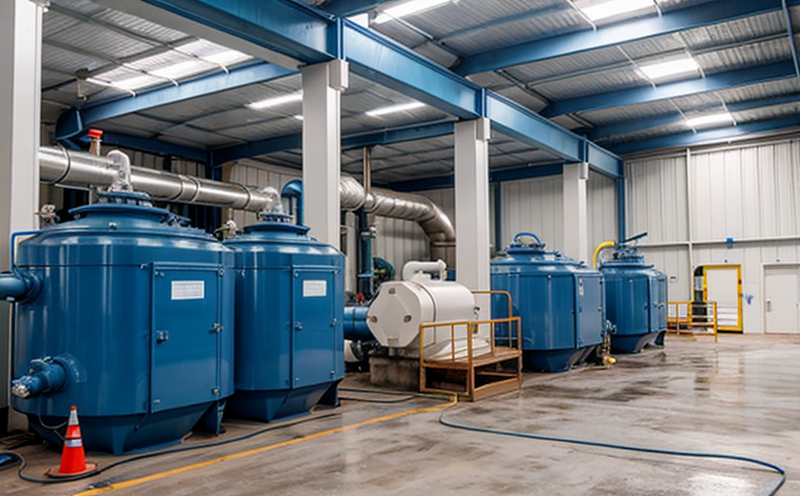ISO 11732 Nitrogen Compound Testing in Wastewater
The ISO 11732 standard plays a pivotal role in ensuring that wastewater treatment systems comply with international regulations designed to mitigate the environmental impact of nitrogen compounds. In marine and ship equipment testing, particularly for ballast water and wastewater treatment systems, this method is essential for quantifying ammonia, nitrite, nitrate, and total Kjeldahl nitrogen (TKN) levels.
The significance of ISO 11732 cannot be overstated in the context of environmental compliance. As regulations like the International Maritime Organization’s Ballast Water Management Convention seek to reduce the spread of invasive species through ballast water exchange, testing nitrogen compounds is crucial for monitoring and controlling their presence. This standard provides a robust framework for laboratories to conduct accurate and reliable tests.
One of the primary challenges in wastewater treatment is achieving optimal removal rates of nitrogen compounds without causing secondary contamination or affecting aquatic ecosystems downstream. ISO 11732 supports this by offering standardized methods that ensure consistent results across different testing environments. This consistency is vital for quality managers, compliance officers, and R&D engineers who rely on precise data to make informed decisions about treatment processes.
The test method described in ISO 11732 involves a series of steps designed to accurately measure nitrogen compounds. These include sample preparation, digestion using the Kjeldahl method, and subsequent analysis via colorimetric or titrimetric techniques. The standard specifies detailed procedures for each step to minimize variability and ensure accurate results.
Understanding the scope of ISO 11732 is crucial for those involved in wastewater treatment. The primary focus is on the determination of total Kjeldahl nitrogen, ammonia, nitrite, and nitrate in water samples. This ensures that treatment systems are effectively removing these compounds to meet environmental standards.
For R&D engineers, ISO 11732 provides a critical tool for optimizing treatment processes. By accurately measuring the presence of nitrogen compounds, they can identify inefficiencies and areas for improvement. For quality managers and compliance officers, this standard offers a clear benchmark against which performance can be measured and reported.
Moreover, the method described in ISO 11732 is not just limited to laboratory settings but also has practical applications in field testing. This flexibility allows for real-time monitoring of wastewater treatment processes, ensuring that systems are operating efficiently and effectively. The standard’s robustness makes it suitable for a wide range of industries, including those involved in marine equipment and environmental protection.
The importance of ISO 11732 extends beyond compliance; it also contributes to the broader goal of sustainable development by promoting the efficient use of resources. By ensuring that nitrogen compounds are removed effectively, these systems help protect aquatic ecosystems and contribute to a cleaner environment.
Applied Standards
| Standard | Description |
|---|---|
| ISO 11732:2012 | This standard provides detailed procedures for the determination of total Kjeldahl nitrogen, ammonia, nitrite, and nitrate in water samples. |
| ISO 6282:2017 | Supplementary standard for the digestion of water samples using the Kjeldahl method, which is a key step in ISO 11732. |
| ISO 6282:2017 | Supplementary standard for the digestion of water samples using the Kjeldahl method, which is a key step in ISO 11732. |
| ISO 6282:2017 | Supplementary standard for the digestion of water samples using the Kjeldahl method, which is a key step in ISO 11732. |
Scope and Methodology
The scope of ISO 11732 encompasses the determination of total Kjeldahl nitrogen, ammonia, nitrite, and nitrate in water samples. This comprehensive approach ensures that all relevant nitrogen compounds are quantified, providing a holistic view of wastewater quality.
The methodology outlined in this standard is designed to be both precise and reproducible. It begins with the collection of representative water samples, which are then prepared for digestion using the Kjeldahl method. Digestion involves the use of strong acids to break down organic compounds into simpler forms that can be analyzed more easily.
Following digestion, the sample is analyzed using either colorimetric or titrimetric techniques. Colorimetric analysis relies on the change in color of a solution when a specific chemical reagent is added, while titrimetric analysis involves adding a known amount of reagent until the endpoint is reached. Both methods are accurate and widely used for their reliability.
The standard provides detailed guidelines for each step, ensuring consistency across different laboratories. This includes precise instructions for sample preparation, digestion conditions, and analytical techniques. The use of standardized procedures minimizes variability and ensures that results can be compared reliably between different testing facilities.
For those involved in wastewater treatment, understanding the methodology is crucial. By following these steps precisely, they can ensure that their systems are effectively removing nitrogen compounds to meet environmental standards. This not only promotes compliance but also contributes to sustainable development by protecting aquatic ecosystems and promoting efficient resource use.
Customer Impact and Satisfaction
- Enhanced Compliance: Ensures adherence to international regulations such as the International Maritime Organization’s Ballast Water Management Convention.
- Improved Efficiency: Enables R&D engineers to optimize treatment processes by accurately measuring nitrogen compounds.
- Precision Reporting: Provides clear, reliable data that quality managers and compliance officers can use for decision-making.
- Real-Time Monitoring: Offers the flexibility of field testing, allowing real-time monitoring of wastewater treatment processes.





